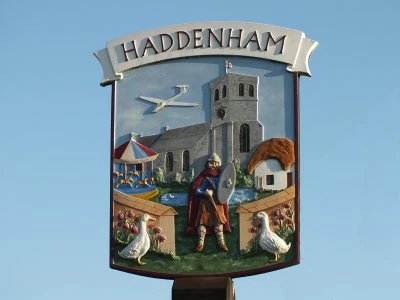Following AVDC's decision not to contest the judicial review of their making ('approving') Haddenham's Neighbourhood Plan, Haddenham Parish Council has issued the following formal statement:
The Application for a Judicial Review of the Haddenham Neighbourhood Plan Statement by Haddenham Parish Council
3rd March 2016
On Tuesday 1st March 2016 Haddenham Parish Council (HPC) was notified by Aylesbury Vale District Council (AVDC) that it would be withdrawing its defence of the application for a Judicial Review of the Haddenham Neighbourhood Plan (HNP).
In a deal with Lightwood Strategic, who made the application, AVDC made an agreement to a Consent Order that will quash Chapter 6 of the HNP which covers housing and development. The other policies and projects included in the HNP will remain. The deal will mean that AVDC can avoid incurring costs were the case to be lost.
HPC has supported AVDC throughout the legal challenge made to its Neighbourhood Plan by registering as an Interested Party. It has provided witness statements and support from its own barristers to refute the claim that errors made in the site assessments of the plan were material. It is however AVDC's responsibility to defend it because they are the Local Planning Authority that formally "made" the HNP (this is the legal shorthand for "AVDC formally made the HNP part of their own Development Plan").
On 1st March AVDC told the Parish Council by phone that the risk of losing the case was seen as too costly by them in the light of their expectation that the housing policies of the HNP – which were based on figures previously advised by AVDC – would be out of date when the housing allocations are made for AVDC's new Vale of Aylesbury Local Plan (VALP).
However, this rationale fails to take account of the fact that their agreement to allow Chapter 6 of the HNP to be quashed leaves the village with no protection from random developer planning applications in the period until a new or revised HNP is developed to plan for the far higher housing allocation envisaged in the new VALP.
The Parish Council still had the option, as a registered Interested Party to defend the Neighbourhood Plan without AVDC.
However, this option was untenable for the following reasons:
1. AVDC's decision that – as they say in their own Press Release – "the best interests of the Council AVDC would be served if it ceased to contest this case" had two consequences
a. To deprive the defence of the HNP of the arguments of an accomplished barrister who was
to represent AVDC.
b. To concede one of the claims made by Lightwood Strategic in applying for a Judicial Review.
AVDC have proposed to concede one of the claims. HPC Counsel have advised that the claim in question could be successfully defended. At this stage we can not legally disclose the specifics of this claim until the Consent Order has been sealed.
2. Of greater significance is that the Judicial Review qualified as what is called an "Aarhus Case". This means that in the event of the case being lost any award of costs is capped at £35,000 for the Defendant.
Whilst HPC was prepared to contest the case, they were registered as an Interested Party and not as the Defendant, and it is not possible for an Interested Party to become a Defendant.
Counsel advised that it could not be guaranteed that the Aarhus cap would still apply for an Interested Party in the absence of a Defendant. Therefore, the more important consequence of AVDC's decision which avoided their possible exposure to £35,000 costs if the case were lost was to instead expose HPC to the potential risk that it could be liable for the full costs incurred by Lightwoods were they to contest it and the case be lost. These costs, it is estimated, could bring the total cost incurred by the Parish Council to a six figure sum but with no quantifiable upper limit. This is as a consequence of there no longer being any Defendant. This is not a risk any parish council is in a position to take and therefore the decision had to be made to agree to the Consent Order.
This is hugely disappointing for the Parish Council and the volunteers who put so many hours into the preparation of the HNP and the Parish Council would like to thank all those who have supported it throughout, in particular those who have withstood the scrutiny imposed on them by this legal process.
The future of Neighbourhood Planning being undertaken by volunteers in their communities appears to be under threat if they cannot be protected by the bodies that are there to support them through the process and beyond. Neighbourhood Planning is now likely to turn into a costly process that is carried out by professionals for those communities with sufficient funding and will be beyond the reach of many smaller communities. This surely goes against the principles of localism on which the neighbourhood planning policy was founded.
In his Report on the HNP in May 2015, Independent Examiner, Nigel McGurk BSc(Hons) MCD MBA MRTPI commented
"I am mindful that neighbourhood planners, by their very nature, tend not to be professional planners. There are examples – especially in neighbourhood planning – of where the "experts," whether planners, lawyers or other practising professionals, have failed to properly grasp legislation. Given this, it would seem unreasonable to expect neighbourhood planners to get everything right all of the time. Most of us are human and we make mistakes. However, such mistakes need not prove fatal to the progress of a neighbourhood plan. Crucially, with regards to all of the above, it is the Independent Examiner's role to consider whether or not the Neighbourhood Plan meets the Basic Conditions" and he found that the HNP did so.
HPC supports the Independent Examiner's view. It calls for urgent action by Central Government to prevent a situation where developers and land traders with deep pockets can employ lawyers to comb Neighbourhood Plans for the inevitable minor errors and oversights as the Independent Examiner described, and then pursue unrelenting legal action contesting those Neighbourhood Plans until the will or financial ability of communities who created them to defend those plans is exhausted.
This is clearly not the intention of the legislation, the National Planning Policy Framework (NPPF), and if it is allowed to become common practice would eradicate Neighbourhood Plans which are so vital to the government's Localism approach.
The Parish Council has budgeted next year to prepare an amendment to the Neighbourhood Plan in the likelihood of a significant increase in the allocation of houses to Haddenham in the VALP. It will therefore be in a good position to start work as soon as possible on the new / amended plan. It is not clear yet how this process can be undertaken as government policy at present does not appear to allow for an amendment without undertaking the full process required when making a plan from scratch but we, like many other parishes in a similar position, are seeking clarity.
Background
On 16th July 2015 51% of the residents of Haddenham turned out to vote by an 86% majority in favour of AVDC using the HNP to help it decide planning applications in the Neighbourhood Area.
The HNP was subsequently 'made' by AVDC on 11th September 2015. This meant that the HNP was adopted as part of AVDC's Development Plan and would hold full weight in its planning decisions.
During the process of making the plan, officers at AVDC advised HPC that it should carry out its own Strategic Environmental Assessment due to the absence of a Local Plan and the likelihood of a significant increase in the allocation of new homes to Haddenham in the developing Vale of Aylesbury Local Plan (VALP).
It was agreed that the figure for Haddenham should be 430.
AVDC Officers advised that there would be the potential for significant environmental impacts of the HNP beyond the current Local Plan and therefore a SEA incorporating a Sustainability Appraisal was recommended to comply with basic conditions. HPC obtained grant funding to take professional advice on the methodology for carrying out this process and the SEA produced as a result was subject to wide consultation and was approved.
As part of the SEA process pro-forma templates were used in order to establish a base line to develop and refine alternatives for the process of assessing individual sites including all those that had been identified by AVDC in its 'call for sites' for the VALP as having potential for development in the HNP area. A series of criteria for assessing the sites was used producing a score for each site. Once the score for each site was established the sites were ranked in priority order and houses were allocated at a specified density to the highest ranked sites.
During the run up to the referendum for the HNP an error was identified that when transcribing the score for the Dollicott Large site from the site assessment to the spreadsheet, this led to this site being given a higher ranking. However, it is the opinion of the Parish Council that this did not make a material difference to the allocation of houses due to the fact that it made no difference to the allocation of houses. An incorrect site assessment form for the Glebe site was uploaded to the website but the correct score for this site was included in the ranking of the sites so again this did not make a material difference.
Whilst the NHP was evolving the Parish Council was approached by 3 developers who planned to submit applications in Haddenham. Two of these developers worked closely with the PC and NP teams to come up with development schemes that conformed to the emerging NP.
Lightwood Strategic, acting on behalf of the Diocese of Oxford and a local land owner, however made it clear that they would proceed with their application for development on the Glebe site despite it conflicting with the emerging NP and not wait for the plan to be made.
Their application was submitted whist the plan was in draft form and AVDC chose to approve the application on the grounds that the emerging HNP did not hold weight. HPC then wrote to the Secretary of State and asked for the application to be 'called in' for him to take the decision out of the hands of AVDC. The request for a calling in was granted and in November 2015 a public inquiry was held for the Inspector to review the evidence and make a recommendation to the Secretary of State.
Prior to the holding of the Inquiry AVDC reconsidered the application in light of the HNP having now been supported by the 86% majority in the referendum, having now been "made" by AVDC, and now holding full legal weight.
Despite this overwhelming expression of the wishes of the village as to precisely where the housing numbers supplied to HPC for the HNP by AVDC should be located in Haddenham, the Strategic Management Development Committee nevertheless again chose to support the planning application with Haddenham and Stone's own District Cllr Michael Edmonds using his casting vote as Chairman to vote in favour of the planning application and against the expressed wishes of the village he represents. This decision was made by balancing the weight of the HNP against the lack of a 5 year housing supply in Aylesbury Vale in a highly subjective interpretation of planning policy and legal precedent. The committee finding in favour of addressing the planning authority's AVDC's own lack of a 5 year housing supply to take precedence.
At this stage the Parish Council became aware that this was not a simple planning issue but a legal one and therefore took the decision to instruct barristers to act on its behalf at the public inquiry. Participation in the Public Inquiry involved considerable cost to HPC. At the public inquiry the volunteers who had carried out the site assessments which went into the HNP were subjected to an unreasonable and potentially libellous questioning regarding how they carried out this task, their abilities and motives. The outcome of the Public Inquiry is due in mid-April 2016.
In order to strengthen their chances of getting their planning application approved by the Secretary of State, on 27th October 2015 Lightwood Strategic filed an application for a judicial review to quash AVDC's decision to make the HNP on the following grounds:
1. The Examiner erred in his interpretation of the basic conditions test I paragraph 8(4) of Schedule 4B of the Town and County Planning Act 1990.
2. The decision to make the HNP is unlawful, as the SEA is defective in its explanation of the selection of the preferred option.
3. The decision to make the HNP is unlawful as the SEA unreasonably fails to consider a "reasonable alternative" to policy HD5.
4. The site allocation made in the HNP proceeded on the basis of a material error of fact, which was subsequently uncorrected by the Examiner.
It is AVDC's choosing not to contest this application that has caused HPC to issue this statement.



